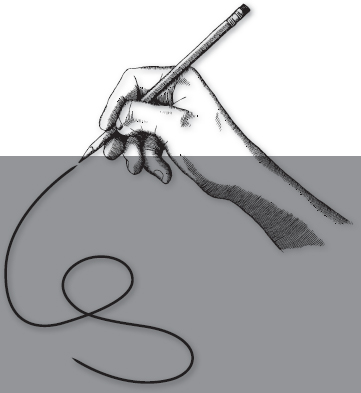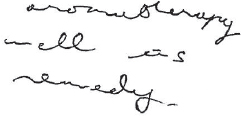
The way we connect the letters in script, or fail to do so, can reveal the way we think and our attitude toward others. It can also tell us whether we rely more on the logical mind or on intuitive faculties when finding solutions to problems. The two factors that need consideration are the way that letters are formed and the way they connect to one another.
The connection and formation styles fall into six categories: copybook, arcade, angular, garland, wavy-line, and threadlike. There are also four common letter styles: artistic, artificial, simple, and copybook. The degree of connection between letters takes two forms. In the first form, most of the letters are joined together to form a continuous active movement, which promotes a fluent and lively pace. In the second, the letters are joined in varying amounts and ways.

People who write with “joined up” letters are logical and well organized. They see the logical order in which to do things and they solve problems in a practical manner. Their conversation flows easily and they mix well with others because they understand relationships. Some people go the extreme of joining up actual words as well as letters because they don't want to lose their train of thinking while they are writing. Such people may find writing something of a strain.
consistency
deductive thinking
good memory
logical mind
sociability
inclined to reach hasty conclusions
inconsiderate
superficiality

In disconnected script, usually no more than three letters are connected to each other in one word. This type of handwriting can point to a thought process influenced by intuition or to a lack of concentration. The writer who does not join letters concentrates on details rather than the whole project. This type of handwriting might be typical of a supervisor who ignores all that you have achieved but picks on the one mistake you've made. This trait can also indicate a writer who comes up with original ideas. Those who write with a disconnected script are influenced by their intuition and they find it difficult to ignore. These writers prefer to keep their distance from others. They can put a barrier around themselves and do not like the close company of others. Because they choose to behave this way, they can suffer loneliness, but they do not display it. These imaginative people channel their inventiveness into an artistic outlet.
artistic
cautious
creative
imaginative
independent
individualistic
intuitive thinkers
inventive
musical
self-reliant
lack of forethought
lonely
moody
stubborn
uncooperative
unreliable
unsociable
There are six basic letter formations in graphology: copybook, arcade, angular, garland, wavy-line, and threadlike. Each of these styles reveals a different personality trait, and these styles are of great importance within handwriting analysis. When in school, we are taught to join our letters with rounded “copybook” connections. Some people retain this particular style, but others find their own connections. The writer's own individual personality is revealed within these formation styles.

Copybook style is taught rigorously in schools. It is the style of more conventional writers, those who have not, as yet, developed a way of thinking for themselves or a personality beyond that of their school days. These writers feel safe by conforming to prescribed and accepted patterns of thought and structured behavior with little or no originality. Some people writing in this style may come from a poor educational background.
This style is rarely used alone because it usually appears within a mixture of styles. It can be used deliberately, for the purpose of disguise (as in anonymous letters). Nuns, nurses, priests, and devoted teachers can write in this way, but don't forget that this style can also hide criminal tendencies.
conventional
predictable
deliberate
lack of originality
not easy to motivate
orthodox habits
slow

The writing of someone who uses the arcade style of script is humped and rounded at the top of the middle zone. The writer of arcade-type script shows a more formal way of styling letters and this indicates that he or she has a traditional sense of values. These individuals are not ones for making instant friendships, as they like to evaluate situations and people before committing themselves. An individual who uses arcade script often is creative; possible tendencies are toward musical talent or having an eye for shape and color. People who write in this style prefer to keep their own counsel and rarely let others know their true thoughts and feelings until they know them well. These writers can mix and communicate well with others when necessary, although they like to keep their personal lives private.
Arcade writers can be staid in their ways and rigid in their thinking. They have their own set of rules from which they operate, and nothing can deter them from their way of doing things, which is the conventional way. Teachers often have this type of writing, as do architects. The m's and n's within the script can be arch shaped.
cautious
confidentiality
constructive conventionality
formal manners
loyalty
retentive memory
security
trustworthiness
close-minded
distrustful
hypocritical
lack of personality and imagination
secretive
stubborn

Angular connections in the middle zone show an analytical mind; the sharp points give the impression of probing. The angular writer is persistent and he doesn't back away from difficult tasks. Individuals with this style of writing have an intelligent approach and self-discipline, and they are willing to work hard in a situation that needs constant attention to detail. The writer whose script is angular displays individuality; the lines are sharp and sometimes even pointed, particularly the tops of the lowercase m's and n's.
People who use this style of writing are shrewd individuals who have a practical and down-to-earth approach. The writer of angular script is critical of others, and if the writer also presses down hard on the page, this can be an indication of aggression. These writers are observant people who are able to concentrate on details. People with large angular writing can be self-centered and possibly lack tolerance for the opinions and ideas of others. An individual with the angular style of writing can be prone to cutting remarks without thought for the other person's feelings. This writer tends to learn by his or her own mistakes.
creative thinking
determined
ethical
hardworking
objective
reliable
argumentative
conflict
cruelty
irritable
lack of compromise
obstinate
resistant to others' ideas
sadism
sharp
tense

Garland script is easily and quickly formed and is usually the script of people who are prone to laziness. They are, however, kind, friendly, and affectionate individuals who do not have aggression in their nature; they prefer harmony to friction in their lives. These people like an active social life and they enjoy the company of friends and family. This person is an excellent host who enjoys entertaining on a grand scale. The person who uses the garland style of writing is also a “Dear Abby,” to whom people are drawn in order to pour out their troubles. People with this writing style are expressive and cooperative and are usually at ease with most people and the environment; they normally avoid conflict. These writers are not competitors; they will compromise by taking the path of least resistance. Some of these individuals are open to emotional influence and can be gullible.
friendliness
kindness
lack of formality
optimistic outlook
receptiveness
complacent
connections and formation
gullible
laziness
tactless
talkative
thoughtlessness
weakness

Writers who use wavy-line formations need freedom to adapt to circumstances and the environment. They do not easily commit themselves fully to any event; they prefer to keep their individuality without obligations. Their thinking is usually flighty and subjective, and they have no definite goals or pattern in life, preferring to ebb and flow with the tide.
freedom loving
go with the flow
avoiding commitment
two-faced

The threadlike formation is like a length of thread laid out on the page, rather than letters being formed, as there is no real letter definition in the writing. Threadlike script is indicative of excellent manipulating ability. These people are mentally alert and difficult to pin down, and others find them particularly difficult to understand. These restless and elusive writers can sometimes be inconsistent. They hate to be tied down to one course of action and like to be free to do their own thing rather than follow any set, structured routine. These individuals can understand other people and have an aptitude for getting their own way without too much trouble. The positive traits associated with this type of writer are that they are quick thinkers and intelligent individuals. On the negative side, these writers can be secretive, they may change facts to suit their own ends, and they can be confused.
The threadlike connection style is, in some instances, almost illegible. This style is often found at the end of a word that ends with -ing, which can be written as one final downward movement. Writers who use the threadlike formation have very strong instincts for self-preservation and they can adapt to any situation, provided it is to their advantage and without loss to their own individuality. If they do not have the freedom to pursue their creative abilities, they will balk at any confined convention. However, they prefer to follow a trouble-free path and avoid restrictions.
These writers have an instinctive, spontaneous understanding of others but can manipulate people to follow their own commands and ideas without being overbearing, and they do have likable personalities. People with this style of writing can be found in the field of psychology, where their strong powers of observation stand them in good stead. They can view both sides of a situation and give advice without being drawn into the situation themselves.
Another type of threadlike connection occurs when the thread is within the word; this connection can appear in any part of a word, and sometimes even throughout the word. In the most negative form of the threadlike connection, a word can be written as one letter followed by a line. Thread writers are indecisive and unsure of themselves, which leaves them open to influence. They find it difficult to cope with external pressures, which they find stressful. These people can be creative but prefer to learn by experience rather than formal training or teaching.
broadminded
individual ideas
need for freedom
reliant on instinct
self-aware
versatile
avoid aggression
feelings of insecurity
hysterical
impressionable
unstable
There are four basic styles to the forms of letters: artistic, artificial, simple, and copybook. Some writers can reduce their basic form to the point of neglect, while others overemphasize with flourishes and embellishments. To be analyzed correctly, the sample of script should be legible, original, and spontaneously written.
Writers who form artistic letters are usually intelligent and naturally artistic. They add ornamentation to their script but retain legibility by the natural way they form their letters.

Very florid and highly adorned and stylized script can belong to a person who is trying to hide an inferiority complex or to give the impression of being artistic or talented, while actually being nothing of the kind.

Writers who produce script that is stripped down to the bare essentials but that still retains legibility have active minds and aesthetic awareness.

These writers prefer friends with whom they can have deep, meaningful discussions, and who can share their interests and intellectual interactions. Such writers can cut corners and simplify tasks to save time and effort. These writers would be unreliable in a situation that demands their concentration on minor details, as they would find it boring and become restless.
While this style of writing is “correct,” there is little individuality, so writers using this form are lacking in imagination and originality. These writers are difficult to motivate; however, they are reliable in situations that require repetitive activity, and they are content to stay within imposed restrictions, as their minds require little stimulus.